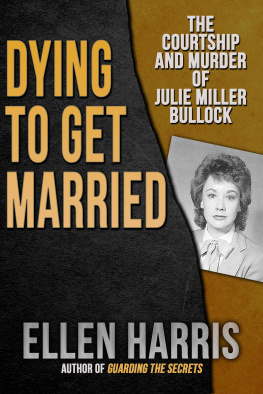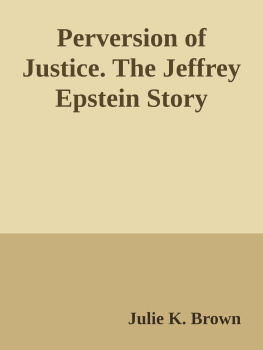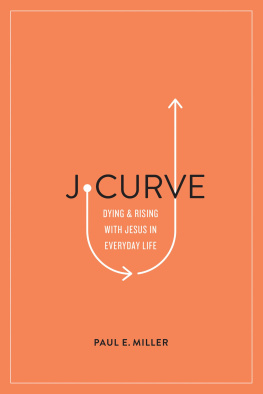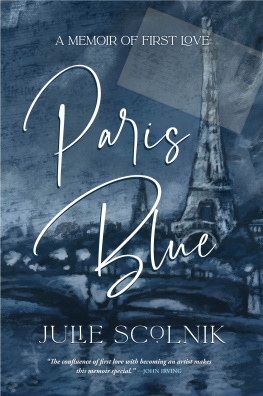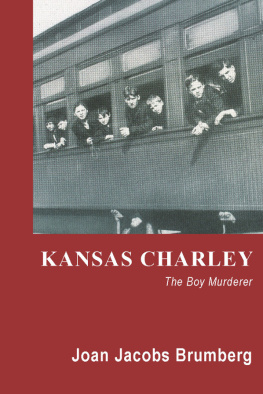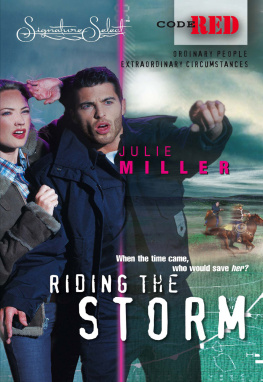DYING TO GET MARRIED
The Courtship and Murder of Julie Miller Bulloch
By Ellen F. Harris
A Gordian Knot True Crime Book
Gordian Knot is an imprint of Crossroad Press
Digital Edition published by Crossroad Press
Smashwords edition published at Smashwords by Crossroad Press
Crossroad Press Digital Edition 2018
Copyright Ellen F. Harris
Original publication by Carol Publishing Group1991
Cover photo courtesy of Carter Miller, Jr.
LICENSE NOTES
This eBook is licensed for your personal enjoyment only. This eBook may not be re-sold or given away to other people. If you would like to share this book with another person, please purchase an additional copy for each person you share it with. If youre reading this book and did not purchase it, or it was not purchased for your use only, then you should return to the vendor of your choice and purchase your own copy. Thank you for respecting the hard work of this author.
Meet the Author
Ellen Harris is the author of two nonfiction books on murder trials:
Dying To Get Married: The Courtship and Murder of Julie Miller Bulloch, tells of an heiress bride killed by her social climbing husband in a sex bondage ritual. He claimed she made me do it. Misogyny affected this case of domestic violence. Dying was also published in France and Great Britain.
Guarding The Secrets: Palestinian Terrorism And A Fathers Murder of His Too-American Daughter reports the first honor killing in America and the network of terrorist cells and safe houses across the U.S. It illustrates the tension between immigrant teenagers trying to assimilate and their parents who demand they follow old country traditions.
Harriss byline has appeared in The New York Times, Newsweek, Bloomberg News, Missouri Lawyers Weekly, St. Louis magazine, and the Post-Dispatch and the American newspapers.
She has been teaching in the Journalism Program at Washington University since 1998. She also teaches in African-American Studies.
An Emmy-Award winning TV producer, she covered the federal and state courts for 15 years at KMOV-TV in St. Louis. Before that she was a general assignment newspaper reporter at the Globe-Democrat.
She has a B.A. in art history from Washington University in St. Louis. She studied architectural history there in graduate school.
DISCOVER CROSSROAD PRESS
Visit the Crossroad site for information about all available products and its authors
Check out our blog
Subscribe to our Newsletter for information about new releases, promotions, and to receive a free eBook
Find and follow us on Facebook
We hope you enjoy this eBook and will seek out other books published by Crossroad Press. We strive to make our eBooks as free of errors as possible, but on occasion some make it into the final product. If you spot any problems, please contact us at and notify us of what you found. Well make the necessary corrections and republish the book. Well also ensure you get the updated version of the eBook.
If you have a moment, the author would appreciate you taking the time to leave a review for this book at the retailers site where you purchased it.
Thank you for your assistance and your support of the authors published by Crossroad Press.
To Shirley Francis Harris
who always said to stand up
and be counted when it mattered;
who always encouraged me
to do whatever I wanted
even when that differed
so much from her values that
she must have felt
she was raising a changling;
who always was generous
even when she must have felt
as though she were wearing
a necklace of serpents teeth;
and who never complained,
Well, not very often.
Table of Contents
Introduction
T he Bulloch case is not one of those modern morality tales called a murder mystery or true crime story in which evil is so satisfyingly punished and good rewarded. The story of Dennis Bulloch is the reverse. It is the story of Prince Charming turning into the frog.
But in this sad story there is one atavistic folktale or moral: Dont judge by appearances. Judging by the jury verdict in the first trial, we have not progressed much from ancient prejudices in which people who were beautiful were believed good and the misshapen evil.
There are three reasons why Dennis Bulloch is not on death row today: He is exceptionally good-looking, especially for a criminal defendant. His criminal defense attorney succeeded at an impossible task. And the jurors chose to believe the unbelievable.
Their verdict was doubly ironic. An essential part of St. Louis is its inherent Midwestern values. That terminal status anxiety one finds on the East Coast where ones real worth seems to be ones net worth does not operate here. The people with real class here are those who treat everyone the same. They may have several sets of silver, but they use only one set of manners. They do not have to run an acquaintance through a power computer to determine if the person is worth consideration.
But to Dennis Bulloch, to be decent to the unimportant was like overpaying his taxes. To Dennis, to be decent was to be ordinary and to be ordinary was failure.
Dennis achieved his goals. He is not ordinary.
The jury verdict in 1987 so outraged me I began this book a month later. It was a why-done-it and an examination of legal issues. Then key issues and themes emerged. Why was there no sympathy for the victim? Why is such violence against women condoned? If Americans become more aware that domestic violence can lead to murder, will the verdicts become more just? Had there been a shelter for abused women near her home and had she gone to one for sanctuary and counseling, would Julie Bulloch's life have been saved? How bad were the scars left on the families and friends by this crime? What good qualities were there in a man who had no conscience? Was there anyone who could always count on Denniss loyalty?
With one exception, Ed Schollmeyer, a high school chum, Denniss friends and former friends and teachers who were interviewed asked that they not be identified. They are afraid Dennis will violently revenge himself on their children or themselves Julie Bullochs friends and brother who were interviewed asked for the same protections. Consequently, not only have the names of these people been changed, so have physical appearances and occupations.
To make this book read more easily, three conversations were reconstructed, based on interviews: the one between Lt. Niere and the firefighters and police officers at the crime scene May 6, 1986, in Chapter One; the scene with Julie and her father in Chapter Five; the conversations with her brother and mother in Chapter Six. Other dialogue, including that in Denniss amatory exercise in assault and his beating of his first wife the night she left him, follows police reports, pre-trial depositions, trial testimony, and conversations repeated to me during interviews.

